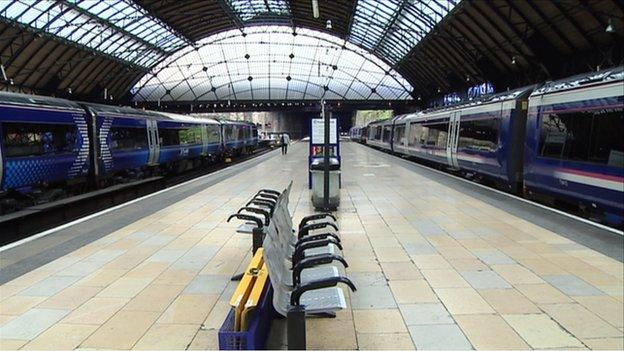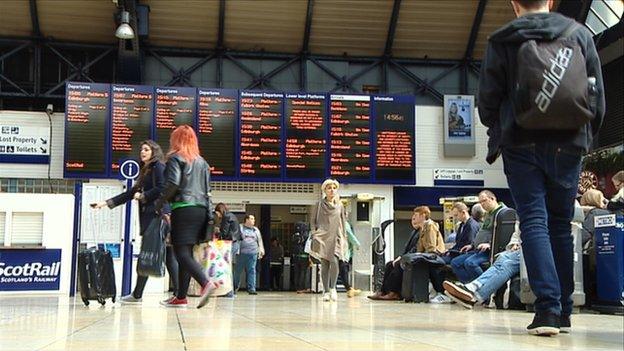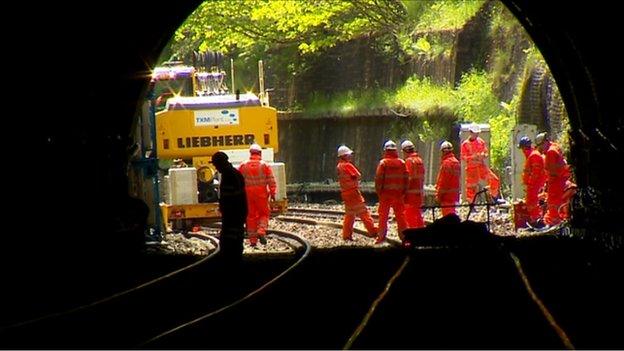How will Winchburgh tunnel rail works affect passengers?
- Published

The Winchburgh railway tunnel in West Lothian has been closed for 44 days causing delays to Glasgow-Edinburgh train services.
Staff will be working round-the-clock in the 330m-long tunnel to lower two lines of track to create space for overhead power lines for the new trains.

Why is this happening now?

The work is part of the £750m Edinburgh Glasgow Improvement Programme (EGIP). It aims to launch "cleaner, greener and quieter trains" on the line from December 2016. This will be mainly done by replacing existing trains with electric-powered ones.
The Winchburgh tunnel, which is near Linlithgow, is the site of a major technical challenge.
The tunnel will be closed between Saturday 13 June and Sunday 26 July, which means trains will need to be diverted and replacement buses used.
Transport Minister Derek Mackay said summer was the quietest time on the railway so it made sense to schedule the tunnel closure at this time.
It includes the school summer holiday period when fewer people travel, but is to be completed before the start of the Edinburgh festivals.

What routes will be affected?

ScotRail said the main routes affected would be:
Glasgow Queen Street High Level - Falkirk High - Edinburgh
Alloa / Dunblane / Stirling - Edinburgh
Linlithgow - Edinburgh Park
Edinburgh - Glenrothes (Fife Circle)
In addition, the following services will be busier than normal in both directions:
Glasgow Queen Street Low Level - Airdrie/Bathgate - Edinburgh
Glasgow Central - Shotts/Motherwell - Edinburgh

What will the closure mean for passengers?

The tunnel closure will mean passengers wanting to travel end-to-end from Glasgow to Edinburgh will no longer be able to take a train from Queen Street high level platforms.
This service will now include replacement bus services around Falkirk.
To avoid that, passengers can switch to the slower Queen Street low level trains, which run on the Airdrie/Bathgate line or travel from Central Station which go via Motherwell/Carstairs or Shotts.
The high level trains will still run every 30 minutes in both directions between Glasgow Queen Street and Linlithgow only - calling at Croy, Falkirk High and Polmont.
ScotRail warned that train journeys would be busier and take longer than normal, they may not depart from where people are used to and in some cases they may involve a bus replacement service.
The train operator has a dedicated website to deal with the questions, external.
ScotRail said it would add extra carriages "where possible" and run more evening rush-hour trains.
It warned that rush-hour trains may be so crowded that some travellers may be unable to board.
It also advised passengers to set off up to 30 minutes earlier than usual.

What about The Open at St Andrews?
Further pressure will come during the Open golf championship at St Andrews from 12-19 July.
Many fans from across Scotland would have travelled by train. ScotRail said it expected to lay on more buses during the latter part of the week.

How much more disruption will there be?
The EGIP project will continue on sections of the Edinburgh Glasgow line until late next year but most of the work will be carried out at night.
Next year, work will begin in the Queen Street tunnel in Glasgow, clearing it for electrification in April 2016.
Phil Verster from train operator ScotRail Alliance said Glasgow Queen Street would be "transformed" by the changes, with the whole concourse being remodelled.
He said: "It will put Glasgow Queen Street on a par with what we have at St Pancras or King's Cross. It is going to be absolutely stunning."

What will the benefits of the improvement programme be?
According to Rodger Querns from EGIP the benefits for passengers will be a 20% reduction in journey times (down from about 52 minutes to 42 minutes on the main line via Falkirk), a 30% increase in capacity and greener, quieter trains with better on-board facilties.
Mr Verster of ScotRail Alliance said: "So on all counts it is good for customers and good for the country."
- Published11 June 2015
